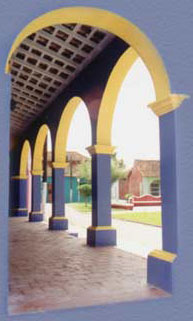
 |
|

Many of the regional styles in Spanish America are song/dance
styles using a 6/8 rhythm syncopated with 2/4 and 3/4 rhythms
(this is known as sesquialtera). The son jarocho
in Mexico is one such style, as is the joropo and
its variations in Venezuela and the tonada and cueca
in Chile. These styles have their origins in the 17th and
18th centuries in Spanish dances such as the fandango,
song styles such as the tonada, and theatrical musical
styles that were brought from Spain in the colonial period.
Another influence was African/Hispanic music developed by
slaves and free blacks.
The son generally has a fast 6/8 rhythm syncopated
against 3/4 (sesquialtera) and certain traditional verse forms
punctuated by choruses and call-and-response interplay between
the singers. The musical framework is a compas, which
is a harmonic and rhythmic phrase repeated throughout the
piece within which the musicians improvise. The son evolved
into distinct types of son in the different regions of Mexico,
and the original violin, harp and guitar-type trio also developed
into different instrumental combinations.
The jarocho son developed in southern Veracruz on the Gulf
of Mexico. Spanish influences include the
harmonic structure, verse forms, the staccato heel dance style
(zapateado), and the stringed instruments. Since
this is a region with a strong African cultural influence
– because imported slaves were used in plantation agriculture
until the early 19th century, and many contemporary jarocho
musicians in the area are African-Mexicans – the son
has African singing characteristics such as short choral responses
to a lead singer (pregonero), slurring or bending
of the notes in characteristic intervals in the scale, and
a sarcastic, irreverent attitude developed among a people
who asserted themselves despite being outside the framework
of the Indian and Spanish societies. Indian influence
is evidenced in the frequent use of animals given human characteristics
(the iguana, the parrot, the bull, the hawk, the dove), marked/staccato
eighth-note rhythm repetitions, and some aspects of the singing
style.
The term jarocho as applied to the people and music of the
region originally meant “irreverent,” but the
people have turned it into an assertion of pride.
During the late Colonial period, the Catholic Church unsuccessfully
tried to suppress the son jarocho because of what they saw
as its devilish qualities. Apparently the bishops took exception
to the sones’ frequent use of sexual doble sentidos
(double meanings) and tendency to make fun of religion, death,
and the church itself.
The musical heart of the jarocho son is the rhythmic and chordal
framework provided by the jarana, a small guitar-type
instrument with five courses of strings, at least 3 of which
are double (making a total of 8-10 strings). The jaranas are
constructed in different sizes. Against this the harp improvises
sparkling, diamond-bright arpeggios and melodies over a syncopated
bass pattern. The small four-string requinto guitar
(also called guitarra de son) plucked with a cow-horn
pick (pua) improvises more percussive melodies.
While harps came over to the Americas from Spain in the 16th
and 17th centuries, they took on different variations of construction
and tone in different Latin American countries and regions.
The 6-string “Spanish guitar” was not developed
in Spain until the late 18th century, and by that time a variety
of distinct guitar-type instruments had developed based on
the early vihuela, which had 6 pairs of strings,
the 4-string Roman guitar and the 5 double-stringed Baroque
guitar. These include the jarana and requinto in Veracruz.
Some groups also use percussion, including the octagonal tambourine
(pandero), donkey jawbone (quijada), wooden
box (cajón) and other drums whose origins
were in Africa, Spain and indigenous Latin American cultures.
To reinforce the bass strings of the harp (or in the absence
of a harp), modern jarocho groups often use electric bass,
acoustic stand-up bass, or guitarrón (large
acoustic bass guitar more commonly associated with mariachi
music of Jalisco). Popular among groups in southern Veracruz
is the use of the leon or leona, a large
baritone requinto that often functions as an acoustic bass.
Also gaining acceptance is the marimbol or marímbola,
an oversize mbira (African thumb piano) with a large
resonator box, on which percussive bass lines are played.
Fandangos
A fandango is an informal gathering of musicians and dancers
to collectively interpret son jarocho. It's not a performance,
but more like a jam session. Sometimes groups take turns playing,
but often everyone plays together. We have helped to organize
many fandangos in Los Angeles and Santa Barbara.
Anyone who is interested is welcome. If you are interested
in attending a fandango, e-mail
us your contact information,
and ask to be added to the fandango mailing list.
|
| |
|
|